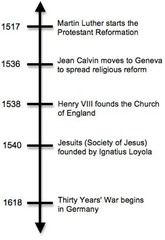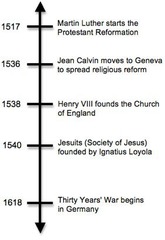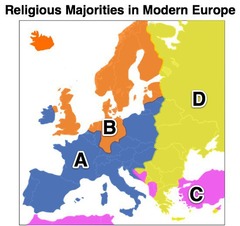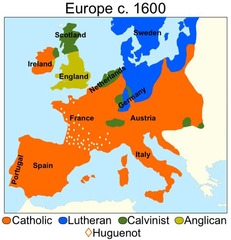A) A series of religious wars in Europe.
B) A substantial increase in religious toleration.
C) A movement within the Catholic Church to correct abuses.
D) The establishment of several Protestant denominations in Europe.
A) France
B) Mexico
C) Germany
D) Great Britain
A) The Counter Reformation
B) The Catholic Reformation
C) The Scientific Revolution
D) The Protestant Reformation
A) that obedience to God was not as important as obedience to the state.
B) that the power of the state was more important than individual liberty.
C) that the teachings of the ancient Greeks had no place in Renaissance thought.
D) that the individual has importance and his achievements should be celebrated.
-Francesco Petrarch, 1365 AD
Petrarch’s letter MOST LIKELY reflects the ideals of
A) humanism.
B) imperialism.
C) liberalism.
D) ostracism.
A) reducing the literacy training of local priests.
B) rejecting the seven sacraments set down by the early church.
C) allowing political leaders to appoint religious leaders, such as bishops.
D) encouraging new religious orders, such as the Jesuits, to set good examples.
A) recreated the old Roman Empire.
B) were located in Northern Europe.
C) were inspired by the renewed interest in Greek and Roman culture.
D) believed that the Catholic Church was in dire need of massive reform.
· The Jesuits
· The Council of Trent
All of these were MAINLY designed for what purpose?
A) end religious wars in Europe
B) retake the Holy Land from the Turks
C) restore the power of the Catholic Church
D) to spread the influence of Christianity to European colonies in Africa
A) Protestants and Catholics.
B) Muslims and Christians.
C) France and England.
D) Germany and Italy.
A) Middle Ages.
B) Renaissance.
C) Industrial Revolution.
D) Protestant Reformation.
A) Humanism
B) Renaissance
C) Counter Reformation
D) Protestant Reformation
A) people across Europe embraced the ideas of religious tolerance.
B) the Catholic Church began to allow its clergy to marry.
C) literacy rate began to rise throughout Europe.
D) the order of Jesuits were disbanded.
A) Lutheran
B) Catholic
C) Greek Orthodox
D) Russian Orthodox
A) it was the first ever epic poem rather than a true comedy.
B) it gave an accurate description of the concept of heaven and hell.
C) it was written in a vernacular language that could be easily understood.
D) it discussed the importance of the Catholic church in the lives of Italians.
A) humanism.
B) realism.
C) classicism.
D) romanticism.
A) nature.
B) politics.
C) religion.
D) science.
A) the power of the Catholic Church should be unquestioned
B) religious officials needed to follow strict rules of behavior
C) music, art, literature, and grammar should be available to all
D) trade and wealth needed to be the goal of all levels of society
A) his contributions to the Protestant Reformation.
B) his attempts to reform the Catholic Church.
C) his exploration of the St. Lawrence River.
D) his founding of the colony of New France.
A) Indulgence.
B) Pilgrimage.
C) Reformation.
D) Predestination.
A) to plan what would become the First Crusade
B) to propose ways to convert Native Americans
C) to kick King Henry VIII of England out of the Catholic Church
D) to address the issues involving the growing Protestant movement
The selling of indulgences a major cause of the
A) Protestant Reformation.
B) Scientific Revolution.
C) Enlightenment.
D) Renaissance.
A) Dominicans
B) Jesuits
C) Presbyterians
D) Protestants
·He used Humanist techniques for interpreting texts, and prepared important new Latin and Greek editions of the New Testament.
·He lived through the Reformation period and his philosophy focused on the importance of a personal relationship with God.
Which humanist philosopher is being described by these statements?
A) Dante Alighieri
B) Sir Thomas More
C) Desiderus Erasmus
D) Francesco Petrarch
A) the Counter Reformation.
B) the Lutheran Revolution.
C) the Glorious Revolution.
D) the Protestant Reformation.
· They worked to convert non-Christians to Catholicism through the use of missionaries.
· They worked to stop Protestantism from spreading throughout Europe.
Created during the Counter Reformation, which Catholic order is being described by these statements?
A) the Jesuits
B) the Clareni
C) the Franciscans
D) the Benedictines
A) Each of us has the free will to determine our own fate.
B) On Judgment Day we are sent to Hell, Purgatory or Heaven.
C) Our direction in life is determined by the people around us.
D) God has chosen a path for each of us to follow before we are born.
A) attack merchants as evil moneychangers
B) portray the clergy as sometimes lustful sinners
C) portray women as real humans and not simply spiritual symbols
D) attack the church for its granting indulgences to the wealthy
A) a reform movement within the Lutheran Church following the Catholic Reformation
B) a reform movement within the Catholic Church following the Protestant Reformation
C) a reform movement that favored the sale of indulgences and permission for priests to marry
D) a reform movement that began in Germany after Martin Luther nailed his “95 Theses” to the Church door in Wittenberg
A) The Council divided the Church, creating a schism between its Eastern Orthodox and Roman Catholic branches.
B) Conservatives defeated reform efforts thus setting the Church on a course that would lead to the Inquisition.
C) The Council strengthened the Papacy, redefined church doctrine, and ended abuses such as the sale of indulgences.
D) Opponents of Protestantism purged the Church of Martin Luther’s influence and restored the power of local bishops.

A) The Jesuits opposed papal authority and attacked the Council of Trent.
B) The Jesuits were the first religious order to allow women into the priesthood.
C) The Jesuits prepared priests to join the Crusades and fight infidels in the Holy Lands.
D) The Jesuits took vows of poverty and chastity and dedicated themselves to living as Jesus did.
A) The Jesuits provided the Church with the first religious order for women.
B) Ignatius Loyola inspired the Pope to seek reforms among the clergy and to redefine Church doctrine.
C) The Jesuits practiced the spiritual beliefs necessary to reform the Church and restore the piety of the clergy.
D) Ignatius Loyola’s scholarship inspired the Pope to focus his efforts on organizational rather than spiritual reform.

A) Thirty Years’ War begins in Germany
B) Henry VIII founds the Church of England
C) Martin Luther starts the Protestant Reformation
D) Jean Calvin moves to Geneva to spread religious reform

A) After 1538
B) Before 1517
C) Between 1517 and 1536
D) Between 1536 and 1538
·Revolutionized the Christian faith when he criticized the Catholic Church and its practices.
·Published The Ninety-Five Theses in 1517.
Which Christian leader and reformer is being described by these statements?
A) John Calvin
B) Martin Luther
C) Johann Tetzel
D) Desiderius Erasmus
A) King James
B) Martin Luther
C) Johann Tetzel
D) Johann Gutenberg
42. Christians are to be taught that the pope does not intend that the buying of indulgences should in any way be compared with works of mercy.
43. Christians are to be taught that he who gives to the poor or lends to the needy does a better deed than he who buys indulgences.
– From 95 Theses, Martin Luther, 1517
According to this excerpt, Luther claimed that indulgences
A) were a good idea.
B) offered people salvation.
C) should be practiced by all Christians.
D) were not as good as other Christian deeds.
A) Practice of tithing.
B) Selling of indulgences.
C) Selling of church positions.
D) Participation in the Crusades.
A) The Catholic church encouraged new ideas and ways of thinking as a way of honoring God.
B) The Catholic church tried to make peace with the Protestants so they could share new ideas.
C) The Catholic church realized that better educated people could earn more money and encouraged it.
D) The Catholic church discouraged new ideas by forbidding certain books and starting the Inquisition.

A) A
B) B
C) C
D) D
A) A
B) B
C) C
D) D
A) humanism
B) lessons
C) reformation
D) renaissance
Why did conflict arise between humanists and the Catholic church?
A) The humanist school were free.
B) The humanists were teaching the same material as the clergy.
C) Many humanist ideas conflicted with the Catholic church ideas.
D) The clergy of the Catholic church were angry to lose their jobs.
A) Spain became a predominately Protestant nation
B) the power of the Catholic Church in Europe was weakened
C) Catholic Church leaders refused to make any changes in church practices
D) the Catholic Church accepted the dominance of the new Protestant religions in Italy, France, and Germany
A) prevent the introduction of Protestant religions.
B) reintroduce African culture to the Iberian Peninsula.
C) encourage the development of the Industrial Revolution.
D) implement the ideas of the Renaissance in major cities.
A) the Crusades were organized
B) new Christian denominations emerged
C) the power of the Pope was strengthened
D) religious teachings were no longer allowed in the universities

A) England
B) Scotland
C) Spain
D) Sweden
A) Humanism
B) Materialism
C) Socialism
D) Spiritualism
A) Dante
B) Erasmus
C) More
D) Petrarch
A) Paul III
B) Gregory IV
C) Benedict X
D) Innocent III
A) founding the Anglican Church
B) heading the Council of Trent
C) ending the Protestant Reformation
D) founding the Presbyterian denomination
A) a Catholic in Italy
B) a Protestant in France
C) a Protestant in England
D) a Presbyterian in Scotland





